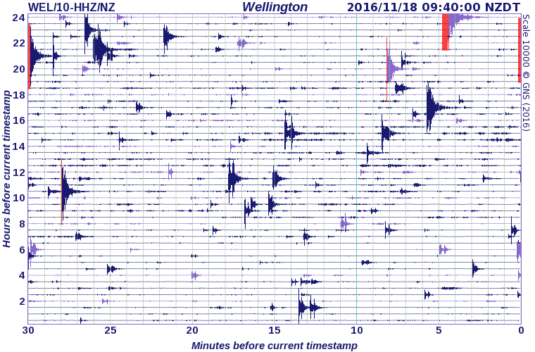After the quake
These are trying and chaotic times, but I hope everyone’s hanging in there. Social media means that there’s more information available than ever before, but also that there’s a lot of misinformation and confusion, so we thought we’d put up a quick post to help you find the most official sources.
Civil Defence’s WREMO page and their WREMO twitter feed are the best places for core emergency information across the region. For Wellington City, the WCC’s twitter account is good for updates, while their city outages and closures page is the best way to get a summary. They link to NZTA and Transport for Wellington for road closures, but they also cover pedestrian cordons that neither of those vehicle-centric sites do. Unfortunately, I haven’t found any up-to-date official overview of building closures: the WCC pages just says “check with the landlord, owner or your employer” which isn’t always helpful, and the situation is changing so rapidly that media sources such as Stuff and Scoop are often out of date. Everyone knows how hard the criminally underfunded GeoNet have been working, and for rapid local quake data I often find myself looking directly at the seismograph drum page: it’s the quickest way to tell whether that shaking you just felt was an aftershock, wind gust, or just your frazzled nerves.

For broader coverage, RNZ has done a stellar job, both over the airwaves and on their RNZ live quake page. Stuff has also had some useful articles, and the Stuff live blog was particularly helpful during Tuesday’s floods. Their twitter account wasn’t so great, though. When train services were briefly halted on Tuesday, they tweeted about that, but included a picture of warped railway lines that an eagle-eyed Twitter user recognised as a recent image from near Blenheim. This sent the misleading message that there was actual damage to the Wellington lines, when in fact it was just precautionary. Trains were back running less than an hour later, but Stuff didn’t issue a timely update, which could have left others misled.
One thing that has astonished me was that anyone who experienced Monday morning’s quake in Wellington could be surprised that some buildings were damaged. It was a Bloody Big Quake by any standards, and though it was some distance away, the Wellington ground shaking was similar to that of the 2013 Seddon quakes and it lasted for a horrifying 90 seconds. Engineers have pointed out that the spectrum of the shaking this time had a greater effect on mid-rise buildings, so buildings that were undamaged in 2013 suffered more stress this time.
But we already have an army of armchair engineers expressing disbelief at the extent of the damage, despite the fact that in Wellington nothing collapsed in the quake and no-one was (as far as I know) seriously injured. Perhaps there needs to be better education about the building code, which doesn’t require buildings to remain unscathed, just that they stand up for long enough for people to escape. Non-structural elements can fail, pipes can burst, exterior details can fall, and the building may be uninhabitable for months or even have to be demolished, and it would still meet the requirements of the code as long as there wasn’t catastrophic structural failure. Eye of the Fish has some informed, measured discussion about the Stats and ICI buildings, and a rather more passionate rejoinder to calls for a red zone. [Update: this Herald article by a professor of civil engineering is the best explanation I’ve seen so far of what buildings are expected to do in an earthquake.]
The time for analysis will come soon, and indeed there will have to be some tough questions asked about specific buildings and about whether the code itself is adequate. As much as I’m happy to blame the government for almost everything, I think that with a few possible exceptions, the blame for the damage can be put down to only one cause: a Bloody Big Quake. Whether you blame that on plate tectonics, Rūaumoko, the supermoon, drilling ships or extra-sexual behaviour is up to you (though you might like to donate to Rainbow Youth and send a receipt to Brian Tamaki). In the meantime, all we can do is remain cautious but calm, realise that many building closures are brief and sensibly precautionary rather than a cause for immediate panic, and look after ourselves and our loved ones.

Thanks for this – I did not know that about the building code.